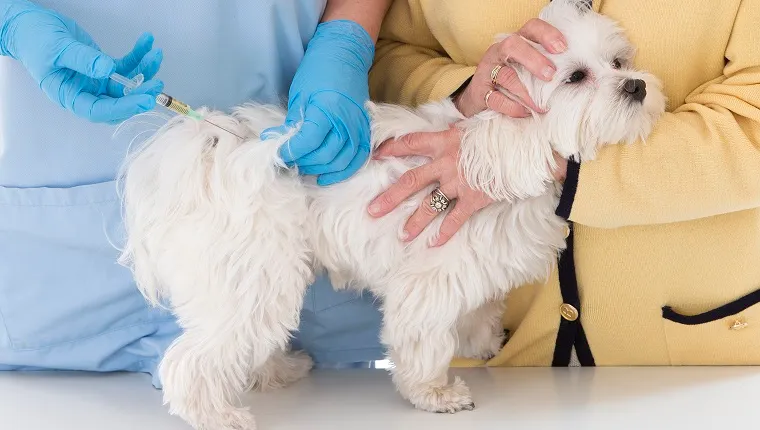Triamcinolone acetonide, commonly known by the brand names Panalog and Vetalog, is a powerful steroid that can be used to treat inflammation, swelling, and itchiness for various conditions in dogs. Veterinarians may further prescribe it as long-term treatment for arthritis and chronic pain or skin conditions caused by allergies.
Because triamcinolone acetonide is so powerful, it must only be used with a prescription and following strict veterinary instructions. Vets will often prescribe the drug in addition to other medications, as it only treats inflammatory symptoms, and not the underlying causes.
It’s important that you follow your vet’s guidelines with this medication and do not discontinue using it until your vet tells you to do so. You can easily buy triamcinolone acetonide online from Chewy’s pharmacy with your vet’s prescription.
Here’s what you should know about the uses, dosage, and side effects of triamcinolone acetonide for dogs.
Uses Of Triamcinolone Acetonide For Dogs

Triamcinolone acetonide can be used to treat dogs for inflammation associated with a variety of conditions in many parts of the body.
Here are a few of the conditions your vet might treat with triamcinolone acetonide:
- Dermatitis
- Seasonal eczema
- Arthritis
- Allergies
- Inflammation from injury
- Granuloma
- Inflammatory eye or ear diseases
Dosage Of Triamcinolone Acetonide For Dogs

The following is only a guideline for typical use of the drug in dogs and must not replace your vet’s advice for your individual dog.
The usual dosage of triamcinolone acetonide for dogs can vary widely depending on their condition and the method of administration. This drug comes in forms that can be given orally as a tablet or syrup, topically as an ointment, or via injection.
Typical dosages range from 0.05 to 1 mg per pound, and dogs may need to take it anywhere from once a day to once per week. Your vet can provide you with further instructions for proper dosage.
Depending on your dog’s response to the treatment, your vet may adjust treatment until they find the proper dosage. It’s important to continue administering the drug to your dog according to your vet’s instructions, even if symptoms improve.
Stopping treatment early could result in your dog relapsing or developing resistance to treatment. Dogs must also be weaned off steroids, as halting treatment abruptly could result in complications such as Addison’s disease.
Side Effects Of Triamcinolone Acetonide In Dogs

There are some common side effects of triamcinolone acetonide in dogs that you should be aware of before you begin treatment.
If the side effects become extreme or cause you concern, you should contact your vet so they can adjust the dosage or try another form of treatment. Long-term use of the drug further increases the risk of side effects.
Here are some of the side effects you might see with use of triamcinolone acetonide in dogs:
- Vomiting
- Diarrhea
- Drowsiness
- Alopecia (hair loss)
- Loss of appetite or excessive eating
- Increased thirst or urination
- Weight gain
- Increased blood pressure
- Reduced immune system function
- Panting
- Aggression or behavioral changes
As with all medications, there’s a risk of allergic reaction that could lead to anaphylaxis. If you see signs of an allergic reaction, then you should contact your vet.
Your vet should also be aware of any other medical conditions your dog has or any other medications they take, as these can react poorly with triamcinolone acetonide. This is especially important in dogs who receive treatment for diabetes with insulin.
Has your dog ever taken triamcinolone acetonide? Did it help your dog’s condition? Then let us know in the comments below!









